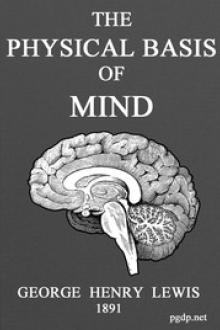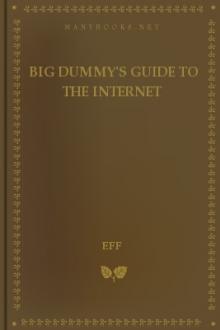Problems of Life and Mind. Second series, George Henry Lewes [e book reading free TXT] 📗

- Author: George Henry Lewes
- Performer: -
Book online «Problems of Life and Mind. Second series, George Henry Lewes [e book reading free TXT] 📗». Author George Henry Lewes
112. The conception of Type as a determining influence arises from that fallacy of taking a resultant for a principle, which has played so conspicuous a part in the history of philosophy. Like many others of its class it exhibits an interesting evolution from the crude metaphysical to the subtle metaphysical point of view, which at last insensibly blends into the positive point of view. At first the Type or Idea was regarded as an objective reality, external to the organism it was supposed to rule. Then this notion was replaced by an approach to the more rational interpretation, the idea was made an internal not an external force, and was incorporated with the material elements of the organism, which were said to “endeavor” to arrange themselves according to the Type. Thus Treviranus declares that the seed “dreams of the future flower”; and “Henle, when he affirms that hair and nails grow in virtue of the Idea, is forced to add that the parts endeavor to arrange themselves according to this Idea.”55 Even Lotze, who has argued so victoriously against the vitalists, and has made it clear that an organism is a vital mechanism, cannot relinquish this conception of legislative Ideas, though he significantly adds, “these have no power in themselves, but only in as far as they are grounded in mechanical conditions.” Why then superfluously add them to the conditions? If every part of a watch, in virtue of the properties inherent in its substance, and of the mutual reactions of these and other parts, has a mechanical value, and if the sum of all these parts is the time-indicating mechanism, do we add to our knowledge of the watch, and our means of repairing or improving it, by assuming that the parts have over and above their physical properties the metaphysical “tendency” or “desire” to arrange themselves into this specific form? When we see that an organism is constructed of various parts, each of which has its own properties inalienable from its structure, and its uses dependent on its relation to other parts, do we gain any larger insight by crediting these parts with desires or “dreams” of a future result which their union will effect? That which is true in this conception of legislative Ideas is that when the parts come together there is mutual reaction, and the resultant of the whole is something very unlike the mere addition of the items, just as water is very unlike oxygen or hydrogen; further, the connexus of the whole impresses a peculiar direction on the development of the parts, and the law of Epigenesis necessitates a serial development, which may easily be interpreted as due to a preordained plan.
113. In a word, this conception of Type only adds a new name to the old difficulty, adding mist to darkness. The law of Epigenesis, which is simply the expression of the material process determined by the polarity of molecules, explains as much of the phenomena as is explicable. A lost limb is replaced by the very processes, and through the same progressive stages as those which originally produced it. We have a demonstration of its not being reformed according to any Idea or Type which exists apart from the immanent properties of the organic molecules, in the fact that it is not reformed at once, but by gradual evolution; the mass of cells at the stump are cells of embryonic character, cells such as those which originally “crystallized” into muscles, nerves, vessels, and integument, and each cell passes through all its ordinary stages of development. It is to be remembered that so intimately dependent is the result on the determining conditions, that any external influence which disturbs the normal course of development will either produce an anomaly, or frustrate the formation of a new limb altogether. One of my tritons bit off the leg of his female;56 the leg which replaced it was much malformed, and curled over the back so as to be useless; was this according to the Idea? I cut it off, and examined it; all the bones were present, but the humerus was twisted, and of small size. In a few weeks a new leg was developed, and this leg was normal. If the Idea, as a ruling power, determined the growth of this third leg, what determined the second, which was malformed? Are we to suppose that in normal growth the Idea prevails, in abnormal the conditions? That it is the polarity of the molecules which at each moment determines the group those molecules will assume, is well seen in the experiment of Lavalle mentioned by Bronn.57 He showed that if when an octohedral crystal is forming, an angle be cut away, so as to produce an artificial surface, a similar surface is produced spontaneously on the corresponding angle, whereas all the other angles are sharply defined. “Valentin,” says Mr. Darwin, “injured the caudal extremity of an embryo, and three days afterwards it produced rudiments of a double pelvis, and of double hind limbs. Hunter and others have observed lizards with their tails reproduced and doubled. When Bonnet divided longitudinally the foot of the salamander, several additional digits were occasionally formed.”58 Where is the evidence of the Idea in these cases?
114. I repeat, the reproduction of lost limbs is due to a process which is in all essential respects the same as that which originally produced them; the genesis of one group of cells is the necessary condition for the genesis of its successor, nor can this order be transposed. But—and the point is very important—it is not every part that can be reproduced, nor is it every animal that has reproductive powers. The worm, or the mollusk, seems capable of reproducing every part; the crab will reproduce its claws, but not its head or tail; the perfect insect of the higher orders will reproduce no part (indeed the amputation of its antennae only is fatal), the salamander will reproduce its leg, the frog not. In human beings a muscle is said never to be reproduced; but this is not the case in the rare examples of supplementary fingers and toes, which have been known to grow again after amputation. The explanation of this difference in the reproductive powers of different animals is usually assigned to the degree in which their organisms retain the embryonic condition; and this explanation is made plausible by the fact that the animals which when adult have no power of replacing lost limbs, have the power when in the larval state. But although this may in some cases be the true explanation, there are many in which it fails, as will be acknowledged after a survey of the extremely various organisms at widely different parts of the animal series which possess the reproductive power. Even animals in the same class, and at the same stage of development, differ in this respect. I do not attach much importance to the fact that all my experiments on marine annelids failed to furnish evidence of their power of reproducing lost segments; because it is difficult to keep them under conditions similar to those in which they live. But it is significant that, among the hundreds which have passed under my observation, not one should have been found with a head-segment in the process of development, replacing one that had been destroyed; and this is all the more remarkable from the great tenacity of life which the mutilated segments manifest. Quatrefages had observed portions of a worm, after gangrene had destroyed its head and several segments, move about in the water and avoid the light!59
115. A final argument to show that the reproduction is not determined by any ruling Idea, but by the organic conditions and the necessary stages of evolution, is seen in the reappearance of a tumor or cancer after it has been removed. We find the new tissue appear with all the characters of the normal tissue of the gland, then rapidly assume one by one the characters of the diseased tissue which had been removed; and there as on is, that the regeneration of the tissue is accompanied by the same abnormal conditions which formerly gave rise to the tumor: the directions of “crystallization” are similar because the conditions are similar. In every case of growth or regrowth the conditions being the same, the result must be the same.
116. It seems a truism to insist that similarity in the results must be due to similarity in the conditions; yet it is one which many theorists disregard; and especially do we need to bear it in





Comments (0)